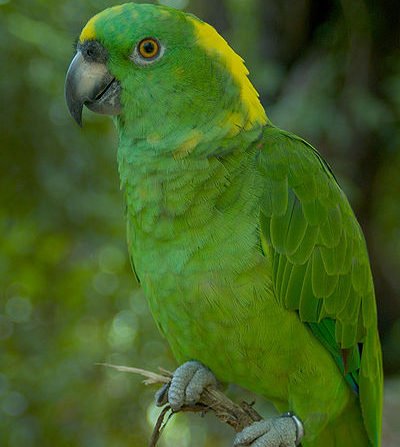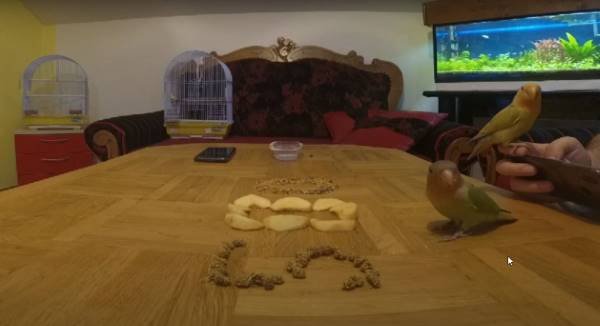Amazona Auropalliata or the Yellow-naped Amazon is a medium-sized parrot from the Amazon parrot family and is one of the most widely petted of all other amazon species. And sadly, it is one of the endangered species of all. The yellow-naped’ population is falling rapidly due to deforestation and illegal capturing of the young birds from the wild. The reason being their ever-increasing demand for their lively personality and age-long companionship. Let’s know possibly all about Yellow-naped Amazons right from the wild to our houses.
Yellow-naped Amazon Habitat
Native to the Pacific region of the northern part of South America and Central America, yellow-naped amazons are specifically concentrated in north-western regions of Costa Rica, El Salvador, Honduras, Guatemala, and southern Mexico. They love to dwell in forests, woodlands, and the tropical areas in the wild.
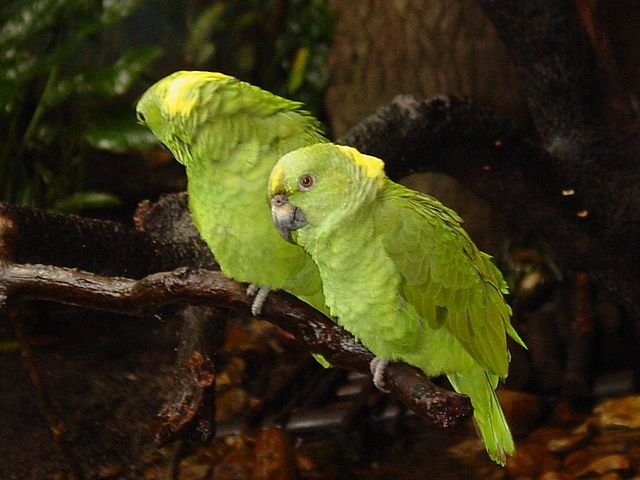
When in the wild, they like to nest in the cavities of the trees. And for their extraordinarily long life’s comfort, they line them with wood shavings and such other natural material.
Yellow-naped Amazon Lifespan
An exceptionally long-lived parrot species, a yellow-naped amazon can live anywhere between 20 to 90 years depending on various factors like habitat, diet, and care affecting his quality of life.
Yellow-naped Amazon Lifespan in the Wild
Yellow-naped is reported to live for around 20 years in their natural habitat. And if they happen to have the safety from predators and good food and water sources around, their lifespan easily extends to around 30 years
Yellow-naped Amazon Lifespan in Captivity
When in captivity, a yellow-naped has a far better quality which makes him live way past than in the wild. A nutritious balanced diet, a happy environment, and a lot of care have been noticed to make a huge difference in their lifespan range.
How long do Yellow-naped Amazon parrots live?
They have been recorded to live for a minimum of 50 years in captivity with average care but with utmost care regime, they can prove to be a long-term companion, living for around 80 years. A few pet yellow-naped have even been recorded to cross their 90th birthdays.
Yellow-naped Amazon Physical Attributes
Yellow-naped Amazons aren’t a small parrot species like lovebirds and hence, not a suitable pet for one and all. Their larger-than-average size and weight must be considered before taking their petting responsibility.
Yellow-naped Amazon Size
A medium-sized parrot species, a yellow-naped amazon measures anywhere between 12 to 15 inches from head to tail. Though not necessary, the male yellow-naped falls on the upper spectrum of the size scale contrary to the females that happen to be a little shorter. They also have a wingspan of around 8 inches going up to 8.5 inches in the larger sized birds.
Yellow-naped Amazon Weight
The yellow-naped amazons are fairly heavy birds weighing one pound on an average. They can weigh anywhere between 480 to 550 kg. And as is seen in most of the parrot species, the males are heavier than their female counterparts.
Yellow-naped Color and Markings
Amazona Auropalliata Auropalliata
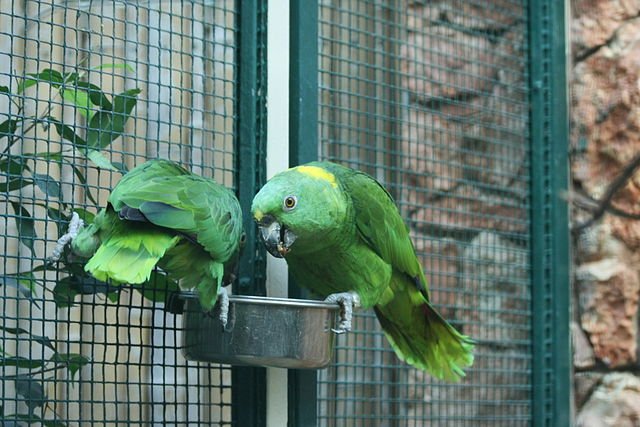
It is the nominate race of Yellow-naped Amazon and can be found from the areas of Southern Mexico stretching to northwestern Costa Rica. There aren’t any visual differences in the markings of a male and female nominate species of yellow-naped. With an overall green plumage and a black beak, the yellow marking at the back of the neck makes the yellow-naped amazon parrot stand out from the other similar looking species.
Sometimes a little yellow is also sprinkled on a few feathers on the head and the neck area. Apart from these yellow markings, all of the bird’s body is a shiny shade of green. The feet are also black or a lighter shade of it sometimes.
Amazona Auropalliata Parvipes
This is the subspecies of the yellow-naped amazon and generally dwells in the northeastern regions of Nicaragua and eastern Honduras’ Mosquito Coast. The color and markings are almost identical to the nominate species but the yellow on the nape is deep and extensive, sometimes on the forehead, eyes, and the crown. The monotony of the green is broken by the red shade in the underside feathers. Bill is almost similar but with dark gray prominent markings. There is not much visual difference between both the sexes.
Amazona Auropalliata Caribaea

This subspecies of the yellow-naped amazon belongs to Honduras and The Bay Islands. The color and markings are again similar to the nominate race. The only difference is that the underparts are more olive-colored than dark green. Also, the plumage is a little lighter shade of green than the nominate race. And the bill is gray with the lower mandible being horn-colored.
Yellow-naped Amazon Color Mutation
Like many other parrot species, there aren’t many color mutations of the yellow-naped amazons. This could very well be attributed to their already endangered status. But there is one known blue color mutation of the bird, though very rare. The Blue Yellow-naped Amazon has a summer sky bluish-green plumage with a dark shade of turquoise wings and a white patch on the nape instead of the usual yellow. The mutation is so rare that it commands around $30,000 from the seeker.
Yellow-naped Amazon vs Yellow-crowned Amazon
Many times, the Yellow-naped Amazon is thought to be the subspecies of a yellow-crowned amazon. But they both are different species altogether. Where the yellow marking in the yellow-naped is at the back of the neck, in yellow-crowned amazons, it can be seen only on the crown area and not on the nape. And in the Double Yellow-headed Amazon, the whole nape and crown are covered with yellow plumage.
Yellow-naped Amazon Diet
Yellow-naped Amazon Diet in the Wild
In their natural habitat, yellow-naped amazons prefer to gorge on a variety of seeds, berries, fruits, nuts, leaf buds, and blossoms.
Yellow-naped Amazon Diet in Captivity
To live as long as a whopping 80 years, one needs a diet that supports body functions at their best. And a yellow-naped also needs to be fed a diet that is not only rich in all the necessary nutrients but also aptly balanced.
Seeds
Seeds are hands-down the favorite food of yellow-naped amazons. This makes it a must food on their daily menu. All kinds of seeds are loaded with huge amounts of good fats and proteins. Offer them quinoa, safflower, chia, barley, millet, pumpkin, amaranth, et al. One can either offer them on alternate days or make a new mix of 2 or 3 of them every day to keep the taste buds of the bird interested.
A few things to consider while offering seeds are:
- Keep the serving quantity small as seeds are high in fat and can be the cause of fat accumulation in the bird. This can lead to diseases like fatty tumors, etc.
- Additionally, it is best to serve the seeds soaked as it reduces the fat content in them. Sprouting them is another great alternative.
- Offer them only homemade seed-mix as the market-made are loaded with added fat and preservatives. Such mixes have been reported as the cause of various diseases among yellow-naped.
Pellets
Pellets form an important part of a yellow-naped daily feed as they happen to balance the nutrient profile of their body. They are loaded with the daily dietary requirements that need to be met in terms of all the essential vitamins and minerals. One can easily have them from a nearby pet store or online. All one needs is to ensure that the brand chosen is of high quality and free from artificial additives.
Fresh Fruits and Vegetables
To make the yellow-naped have a wholesome diet just as in the wild, serving them fresh fruits and vegetables is vital. Offer them bananas, apples, peaches, plums, berries, tomatoes, cherries, pineapples, et al. Though fruits with high sugar content like grapes can be offered too, provided in small quantities. Make sure not to offer the fruits in the dried form as these are loaded with sulfur.
From the vegetable produce, offer them the green leafy ones like spinach, kale, collard greens, green beans, etc to add necessary minerals to their diet. Additionally, to fulfill their vitamin A needs, add dark-skinned veggies like winter squash, pumpkins, or carrots.
But before serving them, it is important to take care of some basic rules:
- Serve all the fruits and vegetables in small pieces or pureed form to avoid the bird getting choked on them.
- Remove all the fruits and vegetables that have been kept uneaten by the bird for 4-5 hours as they might have gone bad. They can be a major cause of bacteria attacking the yellow-naped.
Fresh Water
Water is a life essential and uninterrupted supply of it at all times is a must for the yellow-naped too. Apart from quenching the thirst, water is essential for:
- Regulating the body temperature of the yellow-naped;
- Transport all the minerals throughout the body effectively; and
- Help in performing the major body functions.
That said, the water must be of drinkable quality and hence must either be boiled and then cooled before serving or simply filtered. And make sure to keep changing the water every few hours to avoid contamination by the bacteria.
Essential Minerals
Adding minerals to the yellow-naped diet is extremely important to cover up any deficiency. The best way to do that is to keep a mineral block inside the cage of the bird to let him chew it whenever he wants. Adding a calcium bone is another way to specifically target calcium deficiency and prevent egg-binding in female yellow-naped, especially during the breeding season.
Yellow-naped Amazon Care
The best cage in the world plays a major role in elongating the lifespan of any yellow-naped amazon. It should not only be large enough to make the bird comfortable but be equipped with all the necessities and comforts. After all, the yellow-naped will be spending the rest of 70-80 years of his life there. So, it is extremely important to set up the cage mindfully.
Cage Size
A fun-filled personality, yellow-naped amazon’s cage size must be big enough to let him do his antiques to stay happy and entertained. Having a place to play, hop, and fly a little keeps him immensely cheerful. To offer the yellow-naped unrestricted movement, house him in a cage measuring at least 24 inches in length, width, and height. The bigger the cage, the better it’ll be.
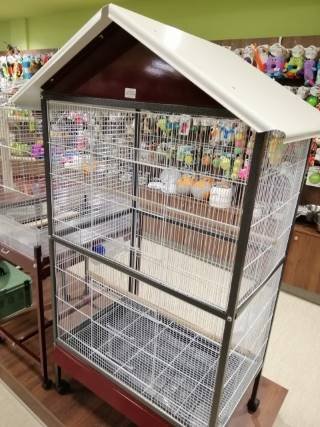
Another key feature of the cage is its bar spacing. Both the horizontal and the vertical bars of the cage must allow the bird to sit and hop around without restrictions. Additionally, to keep the bird safe, the vertical bars must be spaced at not more than half an inch.
Cage necessities
A cage without daily necessities is not of much use for the yellow-naped. And the first thing to add to the cage is the feeding bowls for daily food and water. Ideally, three feeders are kept in the cage; one having the daily seed mix, another filled with the pellets, and the third one with the freshwater. For the hotter days, add another one filled with fresh water for backup. One can place these feeders either on the cage of the floor or clip them on the bars of the cage with the help of the clippers.
Toys
For an active bird like the yellow-naped amazon, toys are an integral part of life. They are not only a source of entertainment for them but also help in channelizing the energy well. And with that huge amount of energy that a yellow-naped has, ensure to keep loads of toys inside the cage to keep the bird physically and mentally engaged.
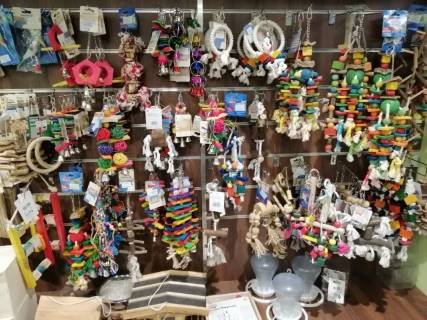
Numerous toys can help in keeping the inquisitive and playful yellow-naped busy. Foraging toys with treats hidden inside them, shiny and textured balls, puzzle toys, spiral ladders, etc. are the toys that can very well feed a yellow-naped stimulated mind. Make sure to keep rotating the toys to keep the game unpredictable.
Perches
Just like in the wild, perches are a need for yellow-naped amazons in captivity too. Add around 5 to 6 perches that are not only of varying sizes but thicknesses too. This will add variety for the bird and make the flexes of the yellow-naped strong in a bid to keep adjusting his hold at perches with varying thicknesses. Another hidden advantage of the perches is that they help in keeping the nails and the beak of the bird trimmed as they get brushed along the wood daily.
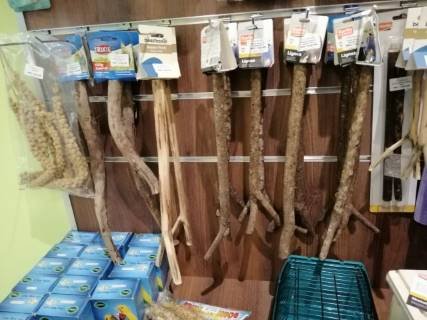
Some facts about Yellow-naped Amazon
- They are also fondly known as Golden-naped Amazons.
- They are terrific flyers when in the wild and fly at quite high altitudes when covering long journeys.
- They are often spotted in extremely huge flocks in the wild.
- Yellow-naped can become couch potatoes pretty quickly and can get extremely fat. For the best of their health, it is imperative to offer them ways for having enough daily exercise and short flights.
Yellow-naped Amazon Price
With the tag of being an endangered parrot species, the yellow-naped amazons can’t be adopted with a lower price tag. They are quite premium priced.
How much does a Yellow-headed Amazon cost?
Depending on the region and the breeder, a yellow-naped amazon can cost anywhere between $2,000 to $3,000. The fact that the bird is parent-raised or hand-raised also impacts the price considerably.
Are Yellow-naped Amazons good pets?
Yellow-naped Amazons make very good pets as they are playful and social. This makes it easy for them to form a bond with their human flock. That said, they are better off for the more experienced bird owners as they need a great deal of attention to stay away from stress and depression.
To be a good pet parrot, many bird lovers also look for the talking ability in their loyal bird companion to have a word or two with their bird. And yellow-naped is the prized talkers of the whole Amazon genus. Unlike many other parrot species, the yellow-naped do not lack clarity in their speech. And they are adept at learning a long list of words and phrases and use them contextually.
Lastly, they aren’t the best of the pet species if one happens to live in an apartment set up. They can be pretty loud at times, especially with their contact calls. That said, they aren’t the noisiest parrot species.
Summing Up
Considered one of the best parrots from the Amazon family, the yellow-naped are famed for their social nature, talking prowess, and remarkable intelligence. But these reasons must not be enough to have one at home. It is very important to seriously consider the extremely long lifespan of this bird as it is quite a commitment. There have been many instances of these birds surviving way past their owners. If the bird happens to be a one-person bird, he may quickly fall into depression. To ensure the happiness of the yellow-naped in such a situation, it is best advised to let the bird form a bond from the beginning with the kids of the family too.
Featured Photo Credit: Andrew Gwozdziewycz from Brooklyn, USA / CC BY-SA

